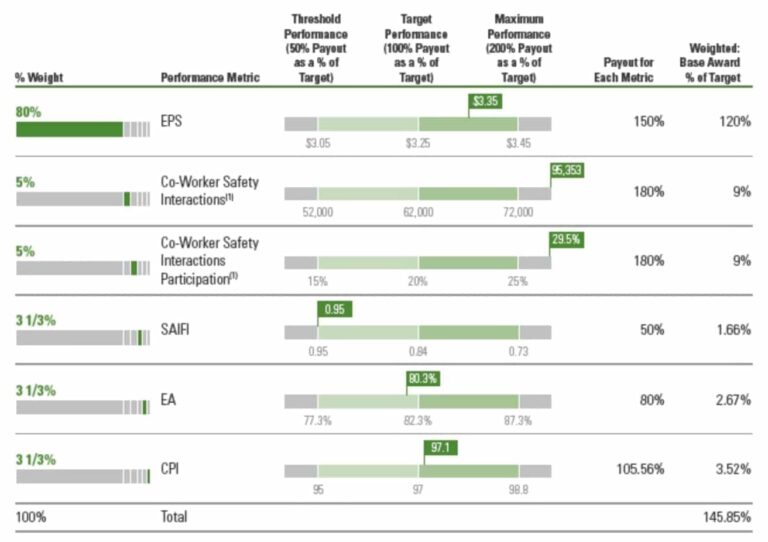Pollution Payday: Analysis of executive compensation and incentives of the largest U.S. investor-owned utilities
Ameren
Ameren is a utility company that serves electric and natural gas customers across Illinois and Missouri. Ameren’s executive compensation plans include a base salary, a short-term incentive plan, and a long-term incentive plan. Ameren’s Board of Directors Human Resources Committee sets these plans.
Executives’ base salaries are fixed and set annually. In 2019, Ameren predominantly weighted CEO Warner L. Baxter’s pay, along with the pay of other named executive officers (NEOs), toward annual and long-term incentives. Baxter’s base salary last year was $1.2 million, an increase from $1 million in 2015, which was his first full year as CEO.
Ameren’s 2019 annual short-term incentive plan consisted mainly of an earnings per share (EPS) incentive at 80% weight. The other 20% of the short-term incentive was made up of safety metrics, outage interruptions, safety, and reliability at the Callaway nuclear energy plant, and a since-removed metric that measured the company’s base-fired coal generation fleet availability. That metric had the effect of creating a financial incentive for company executives to continue to rely on coal.

Ameren set a goal in late 2017 of reducing greenhouse gas emissions by 80% by 2050 from a 2005 baseline, and to invest in 700 MW of wind and 100 MW of solar power. In 2018, the Sierra Club filed a shareholder resolution protesting Ameren’s continued use of a coal availability metric in its incentive structure, to be considered at the 2019 Ameren annual shareholder meeting. Andy Knott, a senior representative for the Sierra Club’s Beyond Coal campaign, told Midwest Energy News that they found the incentive “extremely hypocritical” after announcing the greenhouse gas reduction goal.
The Sierra Club withdrew the proposal after Ameren agreed to assess the “feasibility of integrating metrics for the reduction of Ameren’s carbon output, while removing the coal-fired generation availability metric.” In 2019, Ameren’s Board of Directors Human Resources Committee eliminated the coal metric from the short-term incentive program, and added a long-term incentive that will measure the company’s progress towards renewable generation and energy storage additions; both will be effective for 2020. However, Ameren has not released the specifics of how it will incentivize renewable energy and energy storage additions, and Ameren has not said that it will introduce an executive incentive to directly reduce greenhouse gas emissions.

Ameren’s long-term incentive compensation plan rewards NEOs with Ameren stock based on total shareholder return (TSR). Ameren measures the TSR by the 30-trading-day average of Ameren’s stock price at the beginning of the three-year period on which the long-term incentive is based, and the 30-trading-day average of the price at the end of the period. The company also takes into account dividends paid to shareholders. The TSR is then compared to a group of Ameren’s peers to determine the percentile of Ameren’s performance. At the end of 2019, Ameren’s TSR performance was determined to be in the 69th percentile of its peer group, which resulted in its rewarding NEOs with millions of dollars worth of Ameren stock.
Ameren provides perquisites to its NEOs. The 2020 proxy filing simply states, “We provide limited perquisites to provide competitive value and promote retention of the NEOs and others.” Elsewhere in the proxy statement, these include the following: financial and tax planning services, life insurance, 401(k) employer contributions, matching charitable contributions, ticket and event expenses, and club membership dues “used primarily for business purposes.” Older proxy filings further detail perquisites like spousal travel. Both the 2019 and 2020 proxy filings do not detail the expense totals, whereas in 2018 and 2017 the company reported paying CEO Baxter $10,000 each of the preceding years for tax and financial planning services, for example.
| CEO compensation ranking among utilities studied, 2019 | 16/19 |
| Compensation ratio: CEO to median employee, 2019 | 66:1 |
| Percent change in CEO compensation, 2017-2019 | +20.3% ($1,638,208) |
| Maximum payout of performance-based shares as a percentage of target, 2019 | 200% |
| Is Ameren’s executive compensation structure aligned with decarbonization? | Not directly, pending further details. In 2019, Ameren said that it was adding a long-term incentive that will measure the company’s progress towards renewable generation and energy storage additions, effective 2020. Ameren has agreed to assess the “feasibility of integrating metrics for the reduction of Ameren’s carbon output.” Ameren has not yet released specifics on the new metrics. The company eliminated a coal availability metric from its short-term incentive program in 2019. |
| Is there evidence from SEC filings that Ameren is using misleading financial metrics to determine executive compensation? | No. |
| What key perquisites or benefits do Ameren executives receive? | Executives receive tax and financial planning services, spousal travel, ticket and event costs, club membership dues, matching charitable contributions, 401(k) contributions, and a supplemental executive retirement plan. |
